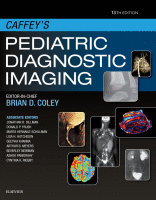Physical Address
304 North Cardinal St.
Dorchester Center, MA 02124

Congenital lesions of the neck consist of a variety of entities, some of which become apparent at birth or shortly thereafter, whereas others present later in life. This chapter will focus on congenital lesions that can be recognized in the…

Embryology of the Neck Accurate diagnosis and successful treatment of congenital anomalies and masses of the neck are dependent on an understanding of the complex embryologic development of this region and the anomalies that result from abnormal development. This chapter…

Overview Pediatric neoplasms of the temporal bone are relatively infrequent. However, the imaging specialist has to be familiar with the common malignancies and their imaging appearances. One important task of the radiologist is to define the extent of the lesion…

Infectious and inflammatory disorders commonly involving the temporal bone; external, middle, and inner ear; and the facial nerve are discussed in this chapter. The auricle, the cartilaginous canal, and the external auditory canal (EAC) comprise the external ear, with the…

The discussion of congenital and neonatal temporal bone abnormalities in this chapter is approached from lateral to medial. External canal atresia and associated middle and inner ear anomalies are discussed initially. Isolated middle ear anomalies with associated branchial arch malformations…

Embryology A detailed study of the development of the ear is beyond the scope of this chapter; only the key embryologic events and their timing are discussed here. It is important to appreciate that the inner ear is derived from…

Development and Anatomy of the Nose and Sinonasal Cavities The craniofacial structures form from a complex sequence of events dictated by molecular changes during the third to 10th gestational weeks. The nose forms in the fourth gestational week from the…

A wide variety of primary and secondary neoplasms may affect the orbit. Most orbital masses are benign and slow growing, but approximately 20% are malignant. Making the correct diagnosis may be difficult for several reasons. In children, it may be…

A wide variety of disease processes can cause inflammatory changes in the orbit, including infection, idiopathic inflammation, granulomatous disease, thyroid-related disease, optic neuritis, and sickle cell disease. Additionally, metabolic diseases can also affect the optic nerves, leading to vision loss.…

Assessment of the orbits is part of a detailed fetal sonographic or magnetic resonance imaging (MRI) scan, particularly in the setting of suspected central nervous system malformation. When further assessment is performed by fetal MRI, obvious ocular pathologies can be…